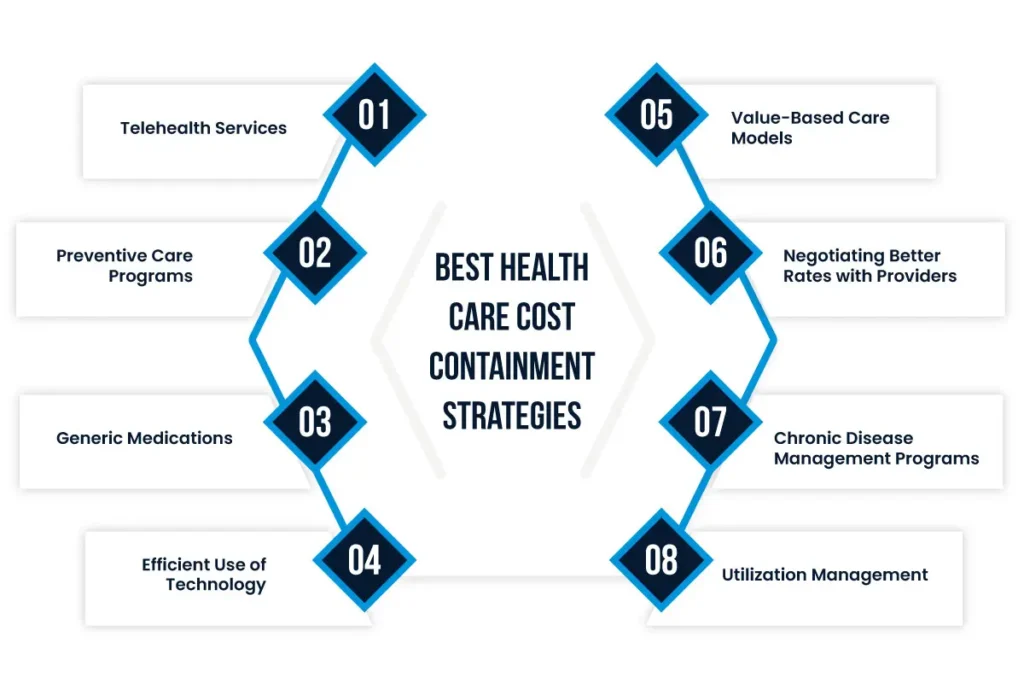

The rising cost of healthcare is a pressing concern that resonates deeply with patients, healthcare providers, and insurance payers alike. As expenses continue to soar, the challenge of providing equitable healthcare access to everyone becomes increasingly daunting. This escalating financial burden is not just a statistic on a balance sheet; it’s a real issue that affects the quality of life and health outcomes for millions of people.
This situation raises several critical questions: How do we ensure that everyone, regardless of their financial status, has access to the healthcare they need? How do healthcare providers manage to maintain high-quality care while grappling with these rising costs? The solution to this multifaceted problem lies in finding innovative cost containment strategies that can bridge the gap between cost efficiency and accessible healthcare.
Healthcare cost containment refers to the strategies and measures employed by healthcare providers, insurers, and policymakers to control or reduce the costs of healthcare services without compromising on the quality of care provided.
By health care cost containment definition, it is about finding a balance. It’s about ensuring that healthcare remains both affordable and accessible to all segments of the population. This involves a range of tactics, from negotiating lower prices for medical services and prescription drugs to implementing preventive care programs that reduce the need for expensive treatments.
The question of why healthcare cost is getting expensive is multifaceted and critical to understand in the context of health care cost containment. Several factors contribute to the escalating costs of healthcare, each intertwined with the complexities of medical care, technological advancements, and economic dynamics.
Firstly, advancements in medical technology and pharmaceuticals, while significantly improving patient care, often come with high price tags. Innovative treatments, state-of-the-art medical equipment, and medications naturally increase healthcare costs. While they offer better outcomes, they require substantial investment in research, development, and implementation.
Another significant factor is the aging population. As people live longer, they tend to require more healthcare services, often for chronic conditions and age-related illnesses. This increased demand places a strain on healthcare resources, driving up costs.
Administrative costs also play a crucial role. The healthcare system involves complex billing, insurance processing, and regulatory compliance requirements, all of which contribute to higher operational expenses.
Furthermore, chronic diseases and lifestyle-related health issues have seen a rise, leading to an increase in the continuous need for healthcare services. This trend not only affects individual health but also adds to the overall healthcare expenditure.
Lastly, there’s the element of market dynamics and policy frameworks. Healthcare does not operate in a vacuum; it is influenced by market forces, government policies, and insurance models. These factors can significantly impact pricing structures and access to healthcare services.
When tackling the challenge of rising healthcare costs, employing the best health care cost containment strategies is essential. These strategies are not just about cutting costs but also about optimizing resource utilization and enhancing the quality of care. Let’s explore some of the most effective strategies being implemented in the healthcare industry today.

Telehealth has emerged as a game-changer in cost containment. By facilitating remote consultations and treatments, telehealth reduces the need for physical office visits, which can be both time-consuming and costly. This not only makes healthcare more accessible but also significantly cuts down on overhead costs associated with in-person care.
Focusing on preventive care is a proactive strategy. By investing in regular screenings, health education, and early intervention programs, healthcare providers can prevent or mitigate serious health issues that would require expensive treatments later.
Encouraging the use of generic medications is another effective cost-containment strategy. Generic drugs are typically much less expensive than their brand-name counterparts while offering the same effectiveness.
Implementing advanced healthcare IT solutions can streamline administrative tasks, reduce paperwork, and improve patient data management, leading to significant cost reductions.
Transitioning from a fee-for-service model to a value-based care model encourages healthcare providers to focus on delivering high-quality care. This model rewards providers for patient health outcomes rather than the volume of services provided, promoting more efficient and effective care.
For insurance companies and large healthcare providers, negotiating better rates for services and products can lead to substantial cost savings.
Developing comprehensive management programs for chronic diseases helps in reducing the need for expensive emergency care and hospitalizations.
This involves reviewing and managing patient care to ensure that it’s necessary and effective, preventing unnecessary procedures and tests.
Each of these strategies contributes to a more sustainable healthcare system by reducing costs while maintaining, or even improving, the quality of care. As we continue to face the challenges of an evolving healthcare landscape, these cost containment strategies will play a pivotal role in ensuring that healthcare remains accessible and affordable for all.
The integration of telehealth solutions into the healthcare system is a transformative strategy for health care cost containment. Telehealth, which encompasses various forms of health care services delivered remotely, plays a crucial role in reducing costs while maintaining high-quality patient care. Let’s delve into how telehealth is making this possible.
Reduced Overhead Costs: Telehealth significantly cuts down on the overhead costs associated with physical medical facilities. By conducting consultations online, healthcare providers can reduce the need for large office spaces, thereby saving on rent, utilities, and maintenance.
Improved Access in Remote Areas: Telehealth bridges the gap for patients in remote or underserved areas who otherwise would incur substantial travel expenses for healthcare. This not only saves costs for patients but also reduces the pressure on centralized healthcare facilities.
Efficiency in Resource Utilization: With telehealth, healthcare providers can see more patients in a shorter amount of time. This efficient use of provider time translates into cost savings for both the healthcare system and patients.
Reduced Hospital Readmissions: Telehealth enables better follow-up care and monitoring of patients, particularly after hospital discharge. This proactive approach can prevent complications and reduce the likelihood of costly hospital readmissions.
As we wrap up our exploration of health care cost containment and the pivotal role of telehealth in this arena, it’s clear that the landscape of healthcare is evolving rapidly. The challenges presented by rising healthcare costs demand innovative, effective solutions, and telehealth has emerged as a key player in this transformation.
Telehealth is not just a technological advancement; it’s a paradigm shift in how we think about and deliver healthcare. By breaking down barriers to access, streamlining processes, and focusing on preventive care and efficient management of chronic conditions, telehealth is helping to make healthcare more affordable and accessible for all.
If you want to tackle healthcare rising cost charges and want to see how telehealth can help you, Get started with Global Touch Telehealth solutions now!
Talk to an Expert Now